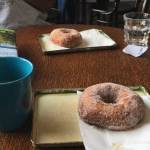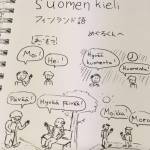We had our first Japanese-Finnish meeting at Pyynikin Munkkikahvila on September 10th. My pair Meguru had heard about fluffy doughnuts sold in Tampere, and I figured out those meant Pyynikki’s.
First I tried to teach Meguru how to order a doughnut in Finnish. By some weird chance the cafe clerk was also Japanese and started talking to us in Japanese. Meguru ordered a doughnut in Finnish anyway and it went well.
Then we talked about our lives and practiced Finnish greetings while munching donuts. I gave Meguru a notebook where I’d already written some phrases and numbers before the meeting – which was a good idea because after eating the doughnuts our hands were full of sugar. We’d agreed to focus more on spoken language and pronunciation in both languages, but I think it’s still useful to have some notes to look at later on.
Learning Finnish pronunciation seems fairly easy for a Japanese speaking person, since the languages have mostly similar sounds, except for Ä and Ö. Some Finnish words even sound like a Japanese word with completely different meaning and vice versa, so it can get quite funny!
Two major differences stood out between life in Japan and Finland during our conversation. One is that politeness is very important in speech in Japan, but not so much in Finland. It’s possible to talk to your teacher in the same way you talk to your friends in Finnish, but definitely not in Japanese.
Another is that there often are disasters (災害, saigai) in Japan, such as typhoons and earthquakes, but in Finland those are rare. To someone like me who has never experienced an earthquake, Meguru’s story of waking up to one at night was scary. In Finland, the worst that can happen is just a power outage (停電, teiden) due to an autumn storm or heavy snow.
To test my Japanese, Meguru pointed at various things in the café and I had to say in Japanese what each item was. I highly recommend this type of exercise to other EOTO students who are on intermediate level, since it reveals your weak points fast. You can also learn words that sound more natural in a specific situation. For example, an old Finnish coffee pot looks more like やかん (yakan, a tea kettle) than コーヒポット (koohiipotto, a coffee pot).
I had a really fun time talking with Meguru at the café, and hopefully we can visit the Pyynikki observation tower when the weather is better! I learned a useful word for explaining why Tampere is full of construction sites when we left the café: 路面電車 (romen densha) = a tram.




Comments